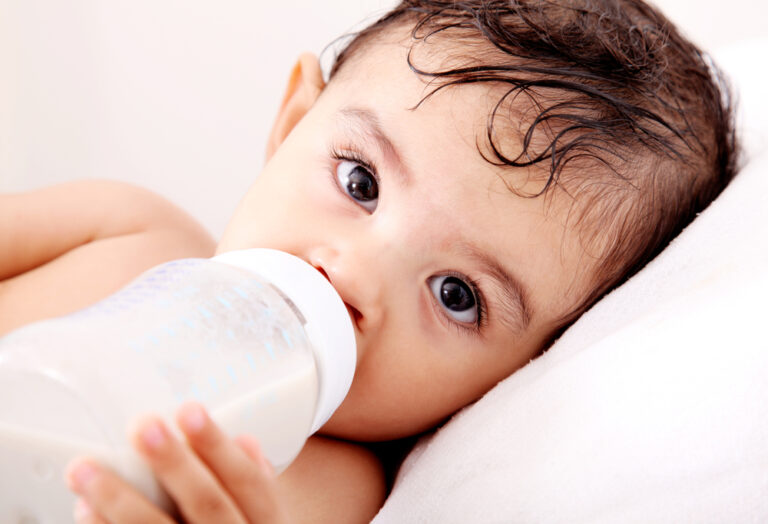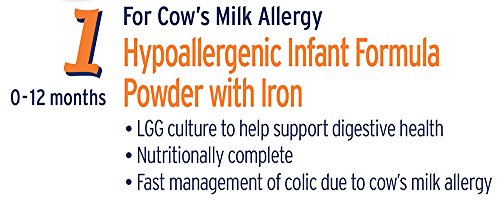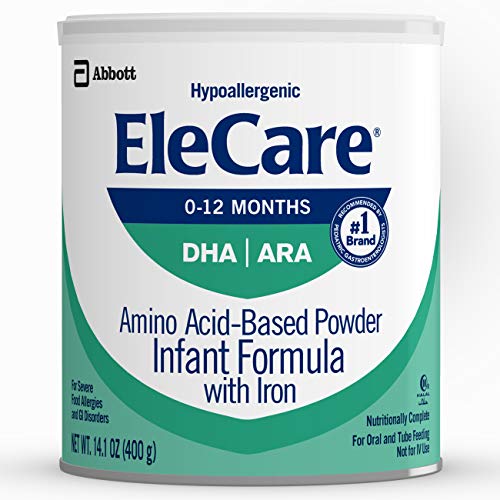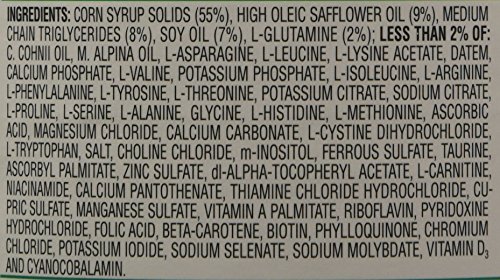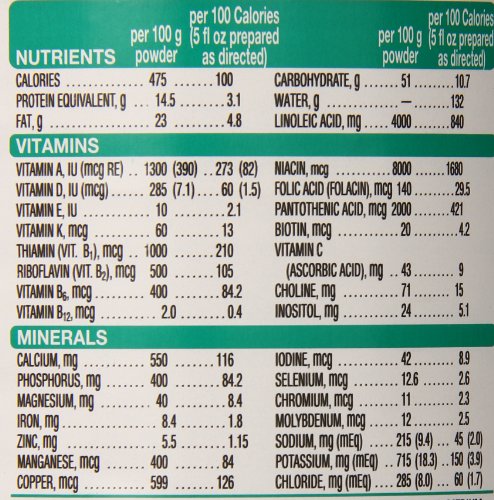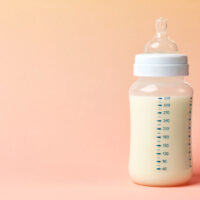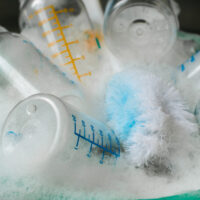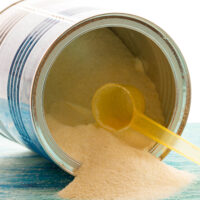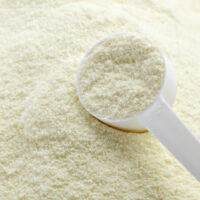Editor’s Note
As of May 2022, many formulas have become increasingly difficult to find. Please read our article, What To Do If You Can’t Find Baby Formula, for more information regarding the formula shortage.
Elecare was part of an infant formula recall in February 2022. Unfortunately, this formula has not been released again for purchase. While there are other lactose-free formulas for babies and toddlers with milk allergies, we suggest you talk to your pediatrician about substitutes for this particular formula since it is used for children with severe allergies to cow’s milk. Neocate is a formula that is similar to Elecare, but it is best to discuss your little one’s allergies with their doctor.
Which of these expensive hypoallergenic formulas should you feed your baby?
Elecare and Nutramigen are two popular infant formula brands for babies with symptoms of cow’s milk protein allergy. These babies may vomit and become lethargic within a few hours of feeding, or develop bloody stools by two to three weeks old. So, which formula works best? Well, the answer depends on your baby’s symptoms. These formulas are intended to address different digestive needs. Nutramigen is an extensively hydrolyzed infant formula. This means that the cow’s milk protein is broken down into smaller particles so that the body doesn’t recognize them as allergens. Nutramigen differs from partially hydrolyzed formulas that are for babies who are colicky but not allergic to this protein. Elecare is made for infants who are severely allergic to cow’s milk, and who still have symptoms when fed a hydrolyzed formula like Nutramigen. Elecare is an amino acid infant formula, meaning the proteins are processed in a way that breaks them down to the base elements. If an infant is given a formula like Nutramigen for 12 weeks but allergy symptoms and poor weight gain persist, most doctors recommend changing to an amino acid formula (source). Babies with this problem often appear very ill, and an amino acid formula can be lifesaving. Neocate is another infant formula that is comparable to Elecare.
Here’s how Nutramigen and Elecare compare.
Nutramigen
Babies cry. That’s just a fact of life. But, babies with colic cry a lot. They spend several hours each evening crying, and can be difficult to console. The colicky phase begins around the second or third week of life, and self-resolves by four months old (source). No exact cause has been identified although many parents attribute it tummy troubles such as gassiness. However, when the crying lasts all day and is associated with other symptoms, it is more than just colic. Vomiting, poor feeding, rashes, and blood in stools are most likely signs of a cow’s milk protein allergy. And, since every feeding session just makes it worse, babies don’t get any relief.
The most common culprit for these symptoms is cow’s milk protein. Two to three percent of infants have an allergy to this protein, and about half of these infants are also allergic to soy (source). Cow’s milk protein allergy is NOT lactose intolerance which is very uncommon in infants (source). When your baby can’t handle cow’s milk protein, they won’t tolerate any of the standard infant formulas on the market. That’s why there’s Nutramigen. This formula is specifically made for little babies with a cow’s milk allergy. Here are the ingredients that help it to be gentle on your allergic baby’s tummy.
- Made with mostly corn syrup solids and vegetable oils, this formula should be gentle on your baby’s tummy because these ingredients are easy to digest. In addition, the casein from cow’s milk is hydrolyzed to prevent an allergy symptoms. Reducing your baby’s exposure to the intact milk protein helps him or her to outgrow this sensitivity, and eventually enjoy regular dairy products (source).
- LGG, or lactobacillus rhamnosis GG, is a probiotic that reduces inflammation in the intestines, and promotes immunity. It helps soothe your baby’s upset tummy, and prepare them for a future full of dairy.
- It contains 27 vitamins and minerals, including inositol and iron. Both of these are found in breast milk, and contribute to your baby’s health.
- You’ll also find DHA, ARA, and choline in this formula. These nutrients are so important for your baby’s brain growth. Since a major component of your baby’s diet is formula, these nutrients are important to obtain during the brain formative years.
- Broken-down proteins contained in this formula are easier for your baby to digest. Because the proteins are hydrolyzed, this formula may also be beneficial for infants with colic (source). According to Enfamil, most parents will notice a big difference in symptoms within 48 hours of taking this formula. However, it may take two weeks for the mucous and blood to no longer appear in your baby’s stools. This is because it takes time for the intestinal inflammation to heal.
- Nutramigen might help build up a tolerance to cow’s milk. The manufacturer claims that giving this formula can reduce the incidence of future allergy-related challenges such as asthma, eczema, eye problems, and other skin problems. This means relief now, and prevention for later. However, evidence of this is not yet been proven by scientific research (source).
Elecare
Some babies have more than just ordinary colic or mild cow’s milk protein allergy symptoms. Some are highly allergic, and can’t handle intact or hydrolyzed casein and whey proteins. This is where Elecare comes in. The proteins in this formula have been broken down into the amino acids which are the basic building blocks of protein. This is the furthest you can break them down and have protein.
This formula is completely hypoallergenic. Babies whose symptoms are not relieved by formulas like Alimentum and Nutramigen improve when switched to Elecare. Any baby who develops anaphylactic reactions, inflammation of the esophagus, or food protein-induced enterocolitis in response to cow’s milk should also tolerate Elecare (source). Soy, another common irritant, has also been omitted from this formula. Here are the ingredients that make it so fantastically gentle to baby’s digestive system.
- Corn syrup solids are the main carbohydrate source, but also improve the palatability of this formula. Next are high-oleic safflower and soy oils, along with hydrolyzed fat in the form of triglycerides. The predominant amino acid is L-glutamine, followed by 15 others. All of these provide the protein, carbohydrates, and fat that your baby needs to survive and thrive during the first year of life.
- 32 different vitamins and minerals can be found in this formula, including the all-important iron, choline, and inositol. These are all designed to mimic the nutrients found in breast milk, and give your baby every single building block they need to grow their mind and body.
- Like all good infant formulas, this one also contains DHA and ARA. These are typically found in human breast milk, and are added to help support your baby’s brain and eye development.
- This formula is completely hypoallergenic. All allergy-inducing ingredients have been removed. Although it does contain some soy oil, this form has not been shown to provoke an allergic reaction due to the absence of soy protein. That means that this formula works particularly well for babies that have multiple food allergies.
- Individual amino acids are a readily available source of protein that prevent inflammation in the intestines, and are easily absorbed. Because there is no allergic response, no symptoms occur.
Biggest Issues: Elecare vs. Nutramigen
Surprisingly, both of these formulas tend to have the same negative qualities. So, instead of discussing the problems twice, I have condensed the cons for both into one section.
The first and most obvious drawback of Nutramigen and Elecare is that they are very pricey. At the time this article was written, the price of Nutramigen was running between 50 and 60 percent higher per ounce than the majority of standard infant formulas. Elecare costs closer to 230 to 240% higher per ounce. That’s a ton of money! When you calculate how much more per month this costs, you start to understand the potential impact on your budget.
I think the reason that the Elecare is more expensive is the cost of processing proteins down to the level of amino acids. Cheaper ingredients such as intact cow’s milk, lactose, and soy cannot be used. Nutramigen is a tiny bit cheaper because casein from cow’s milk is used, but the processing still makes it pricier than regular infant formula. Fortunately, some health insurance companies cover some or all of the cost if the formula is deemed medically necessary. For parents who qualify for WIC, a hypoallergenic formula option is available if the appropriate medical documentation is provided. Pediatrician’s may have samples of these formulas in their offices. Also, another company has developed a generic hydrolyzed infant formula that is much more affordable.
Now that we’ve discussed price, let’s talk about the biggest parent complaint about these formulas. Number one is that the taste and odor of is terrible. Now, if you’ve ever had the pleasure of tasting any type of infant formula, you know that it doesn’t exactly taste great. However, hypoallergenic formulas are particularly unpalatable. This is why large amounts of sugar in the form corn syrup solids are typically the first ingredient. They also lack the creaminess of standard infant formulas.
The amounts of iron and other nutrients in Elecare also make it smell horrible. Looking at its ingredient label, you will notice 8.4mg of iron. Nutramigen and standard infant formulas only contain 1.8mg of iron. We’re talking about more than just a metallic sort of smell, but a “borderline rancid” odor. Many users report difficulty feeding their babies hypoallergenic formulas because of the awful taste and smell. If your infant doesn’t need these formulas because of an allergy, you might be able to mix one with a cheaper, non-hypoallergenic formula. They may be better tolerated this way. In situations of cow’s milk protein allergy, however, you’ll need to do whatever it takes to feed these formulas to your baby.
Speaking of bad odors, you’ll notice it in your baby’s stools and spit-ups. Maybe it’s because of how these formulas are processed, but they seem to make baby reflux smell especially sour. It also gives their stools have a much stronger and more distinct smell. However, the good news is that, with less stomach and intestinal irritation, your baby will have less reflux and diarrhea, so you’ll smell it less often.
The final issue that you’ll notice is how difficult it is to prepare the powdered versions. This is ironic because the components are broken down to make them more digestible and less allergenic. You would think this would enable them to blend well with water. Unfortunately, this is not the case. You must vigorously shake the mixture in order to get it even partially blended. If possible, you might want to use a small mixer to prepare these formulas. If not, you may need to shake the bottle multiple times per feeding in order for it to dissolve.
Once it is finally fully blended, the texture of this formula is a little bit different too. It’s a lot thinner than other formulas. This is most likely due to the lack of intact milk proteins. It seems to be more noticeable with Elecare than Nutramigen. The texture is very thin and runny, more like breast milk than traditional formula. While this may be ideal for some babies, thinner formula is usually not good for reflux.
One last thing worth mentioning is that neither formula is non-GMO. Because both contain corn syrup solids and vegetable oils as their main ingredients, non-GMO sources would be ideal. Discussions about the health effects of GMO food products are still ongoing, and I would prefer if they were not included in formulas intended for infants with allergies (source). While this isn’t a complete deal-breaker, I feel that a non-GMO option would be better.
Enfamil vs. Similac
You may also want to compare infant formula options based on their manufacturer. Read Enfamil formula vs. Similac formula for an overview of their leading products.
